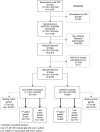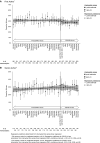Influence of the COVID-19 Pandemic on Author Sex and Manuscript Acceptance Rates among Pulmonary and Critical Care Journals
- PMID: 35588358
- PMCID: PMC9989859
- DOI: 10.1513/AnnalsATS.202203-277OC
Influence of the COVID-19 Pandemic on Author Sex and Manuscript Acceptance Rates among Pulmonary and Critical Care Journals
Abstract
Rationale: The coronavirus disease (COVID-19) pandemic has negatively affected women more than men and may influence the publication of non-COVID-19 research. Objectives: To evaluate whether the COVID-19 pandemic is associated with changes in manuscript acceptance rates among pulmonary/critical care journals and sex-based disparities in these rates. Methods: We analyzed first, senior, and corresponding author sex (female vs. male, identified by matching first names in a validated Genderize database) of manuscripts submitted to four pulmonary/critical care journals between January 1, 2018 and December 31, 2020. We constructed interrupted time series regression models to evaluate whether the proportion of female first and senior authors of non-COVID-19 original research manuscripts changed with the pandemic. Next, we performed multivariable logistic regressions to evaluate the association of author sex with acceptance of original research manuscripts. Results: Among 8,332 original research submissions, women represented 39.9% and 28.3% of first and senior authors, respectively. We found no change in the proportion of female first or senior authors of non-COVID-19 or COVID-19 submitted research manuscripts during the COVID-19 era. Non-COVID-19 manuscripts submitted during the COVID-19 era had reduced odds of acceptance, regardless of author sex (first author adjusted OR [aOR], 0.46 [95% confidence interval (CI), 0.36-0.59]; senior author aOR, 0.46 [95% CI, 0.37-0.57]). Female senior authorship was associated with decreased acceptance of non-COVID-19 research manuscripts (crude rates, 14.4% [male] vs. 13.2% [female]; aOR, 0.84 [95% CI, 0.71-0.99]). Conclusions: Although female author submissions were not disproportionately influenced by COVID-19, we found evidence suggesting sex disparities in manuscript acceptance rates. Journals may need to consider strategies to reduce this disparity, and academic institutions may need to factor our findings, including lower acceptance rates for non-COVID-19 manuscripts, into promotion decisions.
Keywords: COVID-19 pandemic; publications; scholarly publishing; sex bias.
Figures



Similar articles
- Gender Differences in Publication Authorship During COVID-19: A Bibliometric Analysis of High-Impact Cardiology Journals.J Am Heart Assoc. 2021 Feb;10(5):e019005. doi: 10.1161/JAHA.120.019005. Epub 2021 Feb 23.J Am Heart Assoc. 2021.PMID: 33619980Free PMC article.Review.
- Female authorship of covid-19 research in manuscripts submitted to 11 biomedical journals: cross sectional study.BMJ. 2021 Oct 6;375:n2288. doi: 10.1136/bmj.n2288.BMJ. 2021.PMID: 34615650Free PMC article.
- Was the COVID-19 Pandemic Associated with Gender Disparities in Authorship of Manuscripts Submitted to Clinical Neuropsychology Journals?J Int Neuropsychol Soc. 2023 Jan;29(1):105-109. doi: 10.1017/S1355617721001375. Epub 2021 Dec 9.J Int Neuropsychol Soc. 2023.PMID: 34879885
- Gender disparity between authors in leading medical journals during the COVID-19 pandemic: a cross-sectional review.BMJ Open. 2021 Jul 14;11(7):e051224. doi: 10.1136/bmjopen-2021-051224.BMJ Open. 2021.PMID: 34261692Free PMC article.Review.
- Author Gender Inequality in Medical Imaging Journals and the COVID-19 Pandemic.Radiology. 2021 Jul;300(1):E301-E307. doi: 10.1148/radiol.2021204417. Epub 2021 Mar 16.Radiology. 2021.PMID: 33724061Free PMC article.
Cited by
- Scientific authorship by gender: trends before and during a global pandemic.Humanit Soc Sci Commun. 2022;9(1):348. doi: 10.1057/s41599-022-01365-4. Epub 2022 Oct 4.Humanit Soc Sci Commun. 2022.PMID: 36212912Free PMC article.
- Gender analysis of Journal of Perinatology authorship during COVID-19.J Perinatol. 2023 Apr;43(4):518-522. doi: 10.1038/s41372-022-01551-x. Epub 2022 Nov 5.J Perinatol. 2023.PMID: 36335276Free PMC article.
- Gender Disparity in Leading Authorship of Critical Care Clinical Trials: A Systematic Review and Meta-Analysis.Cureus. 2024 Apr 3;16(4):e57528. doi: 10.7759/cureus.57528. eCollection 2024 Apr.Cureus. 2024.PMID: 38707086Free PMC article.Review.
References
- Godlee F. Covid-19: why we still need more women in academia. BMJ . 2020;371:m4161.
- Myers KR, Tham WY, Yin Y, Cohodes N, Thursby JG, Thursby MC, et al. Unequal effects of the COVID-19 pandemic on scientists. Nat Hum Behav . 2020;4:880–883. - PubMed
Publication types
MeSH terms
Grants and funding
LinkOut - more resources
Full Text Sources
Medical

